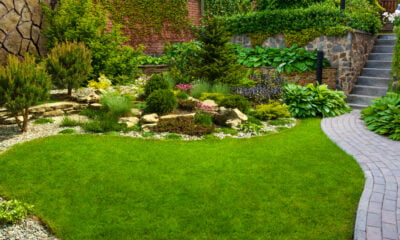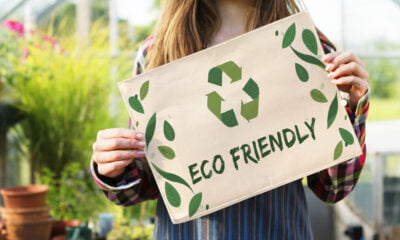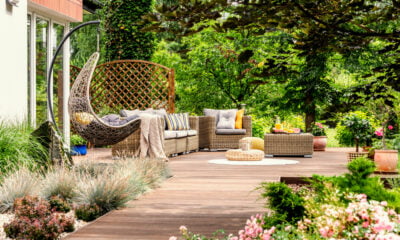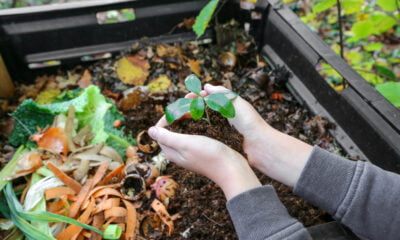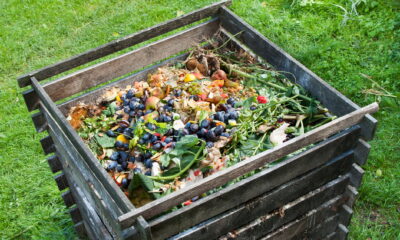

Environment
Proven Tips to Build a Beautiful Sustainable Garden
Gardening is more popular than ever. Around 80% of people grow their own food.
One of the biggest reasons people grow their own food is to lower their carbon footprint. Sustainable gardening is all about using minimal natural resources and reducing your garden’s carbon footprint to help slow down climate change. The American Horticultural Society has a good overview on eco-friendly gardening and we have a number of articles on this site on the topic if you want to learn more.
Everyone can get involved in sustainable gardening, whether you have a sprawling garden of several acres or even just a patio or balcony space.
Building a sustainable garden isn’t nearly as difficult as it sounds. Sure, it may take time and effort to master some aspects of a sustainable lifestyle through gardening, but some sustainable garden ideas are so simple that you’ll wonder why you haven’t adopted them before.
Tending an eco-friendly garden can work out to involve less maintenance and also save you money!
Add Evergreen Plants
Evergreen plants are valuable additions to any outdoor space. They provide local wildlife a habitat throughout the year, sheltering them from cold temperatures and heavy rainfall. Hedges are an excellent way to incorporate evergreens into your garden design. They absorb pollution and noise and allow small animals to crawl underneath, making them more environmentally sound garden boundaries than fences.
As well as providing year-round colour and privacy screening, evergreen trees and shrubs help shelter our homes from chilly winter winds, meaning central heating doesn’t need cranked up so high and saving energy. Check-in with your local garden centre to ensure evergreens are sourced from a nearby nursery.
Collecting and Conserving Water
One of the easiest ways to begin your sustainable gardening journey is to collect and save water. Water is essential for healthy plant growth. However, it is not an infinite resource, especially in the south of the UK, where hosepipe bans are often required to conserve as much water as possible in the hottest, driest months of the year – exactly when plants need it most!
Rain barrels and water butts are great investments for collecting and storing rainwater. They’re not hugely expensive to buy, and the money saved on water bills will soon cover the initial cost. As well as saving money and resources, using a water butt to collect and store rainfall allows plants to be watered as nature intended, without the chlorine, fluoride and limescale often found in tap water.
Leave the Lawn to Grow
Another super-simple and cost-effective way to maintain a sustainable garden is to leave your grass to grow. Whether you’d prefer to section off part of the lawn or are happy for nature to take over the whole space, leaving your lawn to grow wild has many benefits. For example, it provides shelter for beetles and other beneficial insects, while birds will feed on the seeds. Mix in some wildflowers for glorious summer colour, and finally mow the lawn towards the end of autumn.
Even if you don’t want to commit to a fully overgrown lawn throughout summer, postpone the first mowing of spring to later in the growing season. Doing this allows daisies, dandelions and even spring crocuses and daffodils to bloom, offering valuable nectar for early bees and butterflies.
Look at What Grows Locally
Whether it’s seasonal vegetables, colorful flowers or a tall tree, when deciding what to grow in the garden, it’s worth taking some time to consider native plants and flowers. As native plants haven’t been transported from other countries, they have a much lower environmental impact before you’ve even put them in the ground. On top of that, they are more likely to grow well in your garden’s natural soil conditions without the use of harmful chemicals. Native plant species also provide the best shelter and food for local wildlife, such as birds and hedgehogs.
Sustainable Planting
Linked to growing plants native to the local area, sustainable planting places ‘the right plant in the right place’. This sustainable gardening method creates a low-maintenance garden that gives back more than it takes.
Choose native plants and consider their optimum growing conditions to plant them in the perfect spot. For example, some plants grow best in a sheltered position with full sun and well-drained soil. Ensuring these needs are met means the plant will become almost fully self-sufficient, taking all it needs from the surrounding environment, without the need for fertilisers or even additional water in many cases.
Utilise a range of perennials, annuals and shrubs, blooming at different times of year for a hardy and sustainable garden that boosts biodiversity as it flourishes.
Grow Your Own Food
Growing your own produce helps reduce greenhouse gas emissions by reducing the distance food has to travel to the table and is a great way to start adopting sustainable gardening practices. Whether your garden plant choices include planting a fruit tree, creating a vegetable patch or growing your herbs, there are few things more satisfying than enjoying seasonal produce you’ve nurtured and harvested yourself.
Onions, potatoes, peas, basil, mint and oregano are easy to grow, making them a great starting point. Reduce food waste by sharing and swapping your home-grown produce with neighbours, friends and family.
Harvest Seeds at the End of the Season
At the end of the growing season, consider which plants and crops have thrived best in the garden. These are the ones that grow best in your particular garden soil and are worth harvesting. Doing this means you can sow the same plants next year, knowing they are likely to do well and encourage biodiversity.
The key to successfully harvesting and sowing seeds is only to take the seeds from healthy plants. Don’t harvest seeds from a plant that has been plagued with pests all season long, as it’s likely the same thing will happen again. Allow seeds to fully ripen before removing them and let them dry out before storing them away. Save seeds in labelled paper wrapping and place them in an airtight jar or container to keep them in a cool place for the following season.
Limit Hard Landscaping
Hard landscaping, such as paving and decking, can be hugely detrimental to the environment. Not only do the materials used often travel many miles before they reach the garden, hard landscaping also prevents stormwater from draining effectively, leading to flooding.
Permeable surfaces, such as gravel or grass, are much preferred as they allow rainwater to drain away effectively. Often, they are also more aesthetically pleasing than the concrete alternative, meaning your garden will not only be more environmentally friendly, it’ll look better too.
Improve Soil Health
Soil quality is essential for any sustainable garden. Healthy soil can store carbon from the atmosphere, supply plants with valuable nutrients, absorb excess rainfall and provide a home for tiny creatures.
Composting is a great way to naturally enhance soil fertility. It adds nutrients, improves drainage and helps maintain structure.
The easiest way to help soil health is to stop it from becoming compacted. Avoid stepping on it and add organic matter where necessary to stop clay soils from compacting too easily.
One of the best tips for keeping soil healthy is to rotate crops annually. Moving crops around interrupts pests and allows the soil to hold on to its valuable nutrients. Try to ensure the same crop isn’t grown in the same spot for at least 3 years.
Reuse and Recycle
Just like in the rest of the household, a sustainable garden reuses and recycles as much as possible. Re-purpose items wherever possible, finding new uses for things that may otherwise end up in a landfill. Almost anything, from pallets to wire coat hangers can be turned into a support structure for climbing plants, while a lick of paint can make pretty planters out of worn tyres and old kitchen pans.
Many everyday items can be re-used to create an eco-friendly garden. For example, plastic pots can be used over and over again. Just ensure they get washed thoroughly first to remove any traces of disease or pests that might be lurking inside. Tired garden furniture can get sanded down and painted to look like new. Bubble wrap and polystyrene packaging are great for insulating pots to protect plant roots from frost damage. One-off plastics such as yoghurt pots and plastic drinks bottles are ideal for starting seeds and protecting young plants.
With a little creativity, garden waste can get significantly reduced. When you do have to buy new, look for items made from responsibly sourced and/or recycled materials.
Companion Planting
Companion planting is an organic gardening method that positions carefully selected plants side by side so they can benefit from each other. Doing this helps reduce the risk of plant diseases, keeps pests away and increases pollination.
For example, marigolds and thyme are excellent companion plants. Because they have strong scents, they mask the fragrance of their companion, confusing and deterring pests, such as whitefly and aphids. Alternatively, use bright flowers such as lavender or calendula as companion plants for crops. The flowers attract pollinators, which is great for boosting crop yields.
Use Environmentally-Friendly Pest Control
Pest control can be a real headache for those cultivating sustainable gardens. Companion planting does help, but sometimes some additional steps need to be taken to prevent pests from damaging crops.
Avoid using pesticides as much as possible. They may well eradicate the problem, but they are likely to hurt beneficial insects in the process. Sustainable gardens use organic gardening methods for a much gentler approach than resorting to chemicals.
Hand-picking pests from garden plants may not be the most appealing way to spend an afternoon, but it is effective. The pest population can also be reduced by turning the hose on them to wash them away. Cover crops with protective nets to protect them against damage from larger pests.
Plant choices can also help rid the garden of pests. For example, planting lemon balm attracts hoverflies, which feed on garden pests such as mealybugs and aphids. Likewise, dill and coriander attract ladybirds, who also like to eat common garden pests.
Start Home Composting
Making your own compost is a great move towards a sustainable garden. The amount of carbon saved by making just 1kg of homemade compost is the equivalent of driving almost 2 miles in an average car. Not only that, making your own garden compost also helps save money, and it doesn’t come in a single-use plastic bag as many retail composts do.
Compost making is the most eco-friendly way to dispose of garden and kitchen waste. Everything from lawn clippings to tree prunings and uncooked kitchen scraps can be added to the compost pile. Once the organic matter has broken down – this can take 6 months to 2 years – the compost can be used to fertilise the garden.
Use Peat-Free Compost
If you don’t have the space for a compost heap, the next best thing is to use compost that doesn’t include any peat. Peat is organic matter that has been broken down over thousands of years. To harvest it, any crops or plants growing on it have to be cleared, destroying habitats. As peat takes so long to form, it has been harvested faster than it can be replaced and is a finite resource. Around 3,200 million tonnes of carbon is stored in UK peatlands. If this gets harvested, all that carbon is released back into the atmosphere.
The good news is that there are now plenty of great quality peat-free alternatives available. These are nutrient-rich and do exactly the same job. Be mindful that some all-purpose composts do still contain some peat, so read the labels before making a purchase.
Attract Pollinators
Insects are responsible for pollinating 80% of plant species in Europe – including most fruits and vegetables. Pollination is essential for creating future generations of plants, as without it, seeds wouldn’t grow, and plants wouldn’t reproduce.
Bees are perhaps the most famous of all pollinators, but other insects, including beetles, flies, butterflies and ladybirds, also carry pollen between plants. Attracting these insects to the garden helps boost pollination. Planting nectar-rich flowers that bloom throughout the year is the key to helping bees, butterflies, and other essential pollinators thrive. Heather, roses, holly, honeysuckle and blackberry shrubs are all native plants that are a magnet for pollinators.
Hire Energy Efficient Power Tools
Around 45% of off-road petrol emissions come from garden tools. Switching to electric power tools is better for the environment as they don’t spew out toxic fumes and use much less carbon. They are also much quieter to use, resulting in less noise pollution (and happier neighbours!)
Hiring the tools, you don’t use often is more sustainable and cost-effective than buying them – plus you don’t need to find space to store them.
Plant a Tree
We’ve kept the most important top tip for building a sustainable garden to last. Weapons aren’t usually lauded for their beauty, but trees are the exception that proves the rule. Planting trees is the most valuable weapon we have to combat climate change.
Benefits of planting a tree:
- A tree improves air quality by absorbing pollutants, storing carbon and releasing oxygen.
- Trees provide shade, shelter and food for wildlife.
- Heavy rainfall is soaked up by trees, reducing soil erosion.
- Planting trees helps reduce the risk of flooding.
- Tree roots pull nutrients close to the surface, improving soil quality and helping other plants.
- Fruit trees are one of the most environmentally sound ways to grow your own food.
It goes without saying that large trees soak up more carbon dioxide than small trees. However, urban gardens don’t usually have the space for a massive oak tree. If you don’t have acres of land, consider other native species. Crab apple, elder, and holly trees are all great options for outdoor spaces. Alternatively, create your own patio orchard by growing apple, pear and plum trees in containers.
Give Sustainable Gardening a Go
A sustainable garden certainly isn’t an impossible goal. This list of ideas may look daunting, but they don’t all have to be adopted at once. From collecting water to composting grass clippings and food waste, each of these tips will make a difference on its own, and the more sustainable gardening habits you pick up, the more significant that difference will be. Start with the easy practices and take it from there. You’ll soon find yourself enjoying a sustainable garden while wondering why you didn’t do it before!


 Environment10 months ago
Environment10 months agoAre Polymer Banknotes: an Eco-Friendly Trend or a Groundswell?

 Environment11 months ago
Environment11 months agoEco-Friendly Home Improvements: Top 7 Upgrades for 2025

 Features9 months ago
Features9 months agoEco-Friendly Cryptocurrencies: Sustainable Investment Choices

 Features10 months ago
Features10 months agoEco-Friendly Crypto Traders Must Find the Right Exchange
